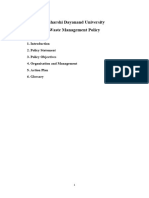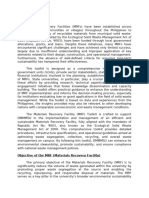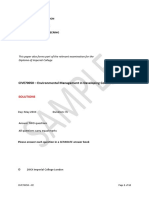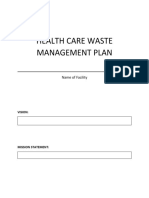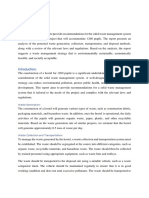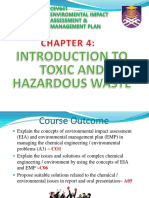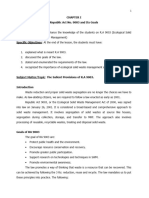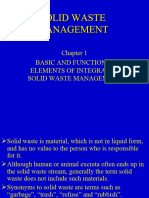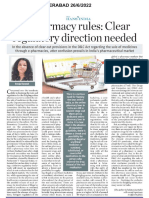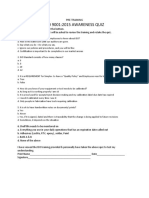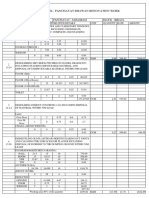Environmental Management System 8.1.9 Waste Management Operational Procedure
Environmental Management System 8.1.9 Waste Management Operational Procedure
Uploaded by
dhir.ankurCopyright:
Available Formats
Environmental Management System 8.1.9 Waste Management Operational Procedure
Environmental Management System 8.1.9 Waste Management Operational Procedure
Uploaded by
dhir.ankurOriginal Title
Copyright
Available Formats
Share this document
Did you find this document useful?
Is this content inappropriate?
Copyright:
Available Formats
Environmental Management System 8.1.9 Waste Management Operational Procedure
Environmental Management System 8.1.9 Waste Management Operational Procedure
Uploaded by
dhir.ankurCopyright:
Available Formats
Environmental Management System –
Documented Information
Environmental Management System
8.1.9 Waste Management Operational Procedure
Issued: September 2019
Author: Fiona Wheatley
Approved by: Fiona Abbott
Review date: 06/09/2019
Clause Ref: Ecocampus and ISO 14001(2015): 8.1
DO NOT PRINT THIS PROCEDURE UNLESS NECESSARY
Environmental Management System –
Documented Information
Management of Waste
1 Purpose
This document sets out how to the University will manage the storage, transfer, re-
use and disposal of its waste, including control of relevant waste documentation. It;
• address the risks and opportunities associated with the waste aspect;
• outlines how waste documentation is stored and maintained;
• outlines the storage and transfer of waste to authorise person/businesses
without harming the environment
• describes the compliance with relevant environmental legislation
2 Definitions
Senior Management – person or group of people who direct and control an
organisation at the highest level.
Risks and Opportunities – potential adverse effects (threats) and potential
beneficial effects (opportunities).
Process – Set of interrelated or interactive activities which transform inputs into
outputs.
3 Responsibilities
Corporate Provide templates to support the waste management
Responsibility practices within the University. Provide information and
team guidance on all matters related to waste management,
internal or external to Swansea University operations.
Offer members of staff and students support, as
required
Waste & Coordinate and develop waste management and
Recycling recycling services across all Swansea University sites.
Officer Responsible for ensuring waste is collected by licenced
contractors and disposed of at authorised facilities, and
ensure waste transfer and consignment notes are
stored as required. Development of waste strategy,
raising awareness and promoting waste and recycling
services, and compliance.
Version 4.0 Uncontrolled if printed 2
Environmental Management System –
Documented Information
Environment Ensuring compliance & deployment through the
Manager University’s EMS.
Head of Primary budget holder for the University waste
Sustainability management contract and the development of waste
management into the Sustainability strategy.
Veolia (main The daily collection of on-campus waste and its transfer
waste to off-site licenced facilities for processing in line with
contractor) the requirements of the waste hierarchy. The provider of
specialist waste services as an when required to the
University as contracted. Provision of all duty of care
waste documentation e.g WTN, structured invoicing for
services, and weight collection data.
Veolia waste Coordinating and overseeing daily on campus waste bin
operatives collections. Coordinating all campuses skip collections
and deliveries. Maintaining and cleaning all waste
compounds. Servicing all external quad bins at Bay
Campus, and 10 at Singleton and collection of any loose
waste found across the campuses whilst carrying out
duties. Completing all internal waste works requests as
contracted. Facilitate access to the primary compounds,
as and when required.
Grounds Staff Maintenance of university grounds including; litter
picking,
and the collection of any loose waste found across the
campuses, located outside the primary vicinity of the
campuses dedicated waste compounds. Taking said
waste to the nearest, or primary waste compound for
recycling by Veolia. Substantive collections of waste
due to ‘fly tipping’ will be removed by Veolia via a Works
Order request.
Cleaning Staff Removal of waste from all internal bins and transfer to
wheelie bins in the waste compounds.
All staff Ensure all waste streams are disposed of in the correct
bins and/or alternative approved manner.
4 Related documents
• Aspects and Impacts Register: Relevant environmental aspects and
associated environmental impacts are detailed within the University and/or
College/PSU Aspect & Impacts Register
• Waste Transfer Notes (WTN)/Waste Consignment Notes (WCN): Waste
transfer notes and consignment notes are official documents that record the
movement of waste from the University site and are stored by the Waste &
Recycling Officer or relevant departmental officer.
Version 4.0 Uncontrolled if printed 3
Environmental Management System –
Documented Information
• Waste Management Guidance Notes (WMGN): Waste Management
Guidance Notes are succinct guides to describe how a waste should be
managed throughout its lifecycle (generation to disposal).
5 Process
5.1 Waste Hierarchy
The Waste Hierarchy must be considered when deciding what the best option is to
manage a waste stream. This is a mandatory requirement of the Waste (England &
Wales) Regulations 2011. It places more emphasis on waste prevention, and
requires organisations to consider preparing waste for reuse, then opportunities for
recycling, before options such as energy recovery. By law, we need to apply the
Waste Hierarchy to ensure we minimise the impacts of our waste activities.
Figure 1: Waste Hierarchy Triangle
The University has committed to segregating its waste at source and focusing on
separating key recycling streams; cans, paper, plastics, food and glass. Segregation
at source improves recyclit quality and the principle is in line with the Waste
Regulations (England and Wales) 2011. The Regulations stipulate that materials
such as paper, metal, plastic and glass must be collected separately if it is necessary
to encourage high quality of the recycling of the material.
5.2 Waste Segregation and Disposal
All waste prior to reuse, recycling or disposal should be held in secure, designated
areas. All waste must be pre-treated (where required), segregated, clearly labelled
and held in areas to prevent escape. Storage facilities for waste must be;
• Safe and secure from unauthorised entry
Version 4.0 Uncontrolled if printed 4
Environmental Management System –
Documented Information
• Robust
• Covered and locked
Waste must only be transported off site by a registered waste carrier and disposed of
at a licensed waste disposal site. The Sustainability team can advise if a contractor
is authorised for the proposed workstream. Dangerous and hazardous waste
materials are to be disposed of in accordance with the Hazardous Waste
Regulations 2005.
Hazardous and non‐hazardous waste must not be put in the same receptacle
5.3 Waste Receptacles
5.3.1 External Waste Receptacles
Across the University campus inhabiting all communal areas, high foot falls areas
and entrance ways ‘quad’ bins have been installed to enable the segregation of
waste and recycling. Only metal, top-opening quads/duos with black bin bags for
non-recycling and clear bags for recycling streams (paper, plastic and cans) are to
be used externally to the specification captured in Figure 1. Figure 2 highlights other
external waste receptacles that are utilised by the University for other recycling
streams.
Figure 2 – Swansea University external ‘quad’ bin
Figure 3 – Swansea University external bins, on order mixed recycling / glass
recycling only / food waste only / coffee cups only
Version 4.0 Uncontrolled if printed 5
Environmental Management System –
Documented Information
5.3.2 Internal waste receptacles
(A) Communal areas and office work spaces
All communal and high-foot fall areas are supplied with internal quad bins (see
Figure 4). Offices and shared work spaces that host 10 or more staff will be provided
with a quad bin. For offices that host less than 10 staff quads and duos will be
located in the immediate area within external corridors, offering a recycling point for
office waste. Individual offices will not be supplied with quads or duo bin however
bins will be located in the immediate area within external corridors, offering a
recycling point for office waste.
Desk bins are not supplied as they are not conducive to improving recycling rates,
and those in current circulation will not be serviced by cleaning staff. Staff can
request desk bin removal be placing a works order via the helpdesk system.
(B) Teaching spaces - Lecture halls and class rooms
Teaching spaces, such as lecture halls hosting more than 100 seats, will have a
quad bin located within the space. Teaching spaces hosting less than 100 seats will
have quad and duo bins located outside the spaces located in the immediate area
within external corridors, offering a recycling point for staff & student waste.
Figure 4 – Swansea University indoor ‘quad’ and ‘duo’ bins
(c) Laboratory and Workshops
For Health & Safety purposes, it is imperative University laboratories and workshops
purchase and install waste bins that are adequate for the waste streams produced,
whether this be chemically contaminated wastes, or clinical health waste. Having the
correct type of bin improves laboratory and workshop safety, as well as cleanliness.
Version 4.0 Uncontrolled if printed 6
Environmental Management System –
Documented Information
The University now has a specification for metal fire retardant, clinical waste grade
bins, which are designed for specialist working areas. Further guidance can be found
here1 on bin sizes and costs. For safety and to eliminate contamination quad bins
should not be placed into laboratories or workshops.
80Litre Metal Sackholder • Metal
• Pedal operated
• Hands free
• Front opening
• Fire retardant
• Easy clean
• Anti-bacterial
Figure 5 – Example of laboratory and workshop compliant bins
All laboratory and workshop bins must have clear labels, to ensure compliance and
correct waste segregation.
Quad and duo bins must not be placed into laboratories or workshops.
5.4 Waste Management Guidance Notes (WMGN)
A range of Waste Management Guidance Notes have been developed to provide
guidance on a wide range of controlled, and hazardous wastes generated by the
University. All guidance notes are reviewed every two years (or earlier if required)
and updated in line with changes to waste regulations, and operational controls.
Each guidance notes outlines; waste duty of care requirements, EWC code, waste
description, internal storage requirements, and confirms the correct disposal
procedure. All guidance notes have been developed in line with current waste
regulations. The core WMGN are outlined below but the current list can be found on
the Sustainability pages on the University website2.
1 Compliant Waste Bins for Chemically Contaminated and Clinical specification guide
available from https://staff.swansea.ac.uk/media/compliant-chemically-contaminated-
and-clinical-waste-bins.pdf
2 https://www.swansea.ac.uk/sustainability/waste/#waste-management-guidance-
notes=is-expanded
Version 4.0 Uncontrolled if printed 7
Environmental Management System –
Documented Information
Non-Hazardous
• WMGN01 Non-Recycling
• WMGN02 Plastic
• WMGN03 Paper
• WMGN04 Food tins and cans
• WMGN05 Confidential Waste
• WMGN06 Cardboard
• WMGN07 Glass
• WMGN08 Wood
• WMGN09 Metal
• WMGN10 Coffee Cups
• WMGN11 Plasterboard
• WMGN12 Stationary
• WMGN13 Used Cooking Oil
Hazardous WEEE
• WMGN14 Toner Cartridges
• WMGN15 Batteries
• WMGN16 Lightbulbs/Fluorescent Tubes
• WMGN17 WEEE
• WMGN18 Paint
• WMGN19 Aerosols
Chemical Waste
• WMGN20 Chemical Waste Classification
• WMGN21 Chemically Contaminated Laboratory Solid Waste (Red Bag)
• WMGN22 Laboratory and Workshop Sharps
• WMGN23 Laboratory and Workshop Glass and Glass Sharps
Clinical and Healthcare hazardous and Non-hazardous Waste
• WMGN24 Anatomical Waste – Human & Animal; Non-chemical & Chemically
Preserved (Red)
• WMGN25 Infectious Clinical Waste (Orange Bag)
• WMGN26 Infectious and Chemically Contaminated Solid and Sharps Waste
(Yellow bag/box)
• WMGN27 Infectious Solid and Sharps Cytotoxic & Cytostatic Waste (Purple)
Version 4.0 Uncontrolled if printed 8
Environmental Management System –
Documented Information
• WMGN28 Other Medicine Waste (Blue)
• WMGN29 Offensive Waste (Black/Yellow)
• WMGN30 Biological
Engineering
• WMGN31 Oil-Contaminated Solid Waste
• WMGN32 Oil Waste
If you have a waste stream not included in the above, please contact estates-
waste@swansea.ac.uk.
5.5 Waste Licenses and Permits
Any activity involving the; storage, use, treatment or disposal of waste on University
grounds requires either;
• an Environmental Permit from the Environmental Regulator, and/or:
• to register an Exemption with the Environmental Regulator, and/or:
• to comply with other terms and conditions where the above are not required
As the volume of hazardous waste produced by the University exceed the Natural
Resources Wales threshold of 500kg, each campus has been registered as a
producer of hazardous waste. The annual registration will be renewed by the
Sustainability Team. For further details regarding waste permits and exemptions, if
you are responsible for storing, or processing any waste ready for disposal, please
contact; estates-waste@swansea.ac.uk.
The University sites are also registered as a Lower Tier Waste
Carrier/Broker/Dealer. These licences will last indefinitely, unless revoked or
withdrawn. Each site is registered; this allows the University to transfer its own non-
hazardous waste in University-owned vehicles, only, between sites. If you carry
waste on the public highway, you must carry a license in your vehicle. These can be
obtained from; estates-waste@swansea.ac.uk.
5.6 Authorised Waste Carrier
Veolia is the main waste contractor for Swansea University; Veolia manage and are
responsible for further sub-contractors. All waste contractors must be authorised as
registered carriers of controlled waste. The University annually checks the
certificates of registrations and their expiry dates for all of the waste contractors
associated with the waste management contract. Evidence of registrations and
permits are stored centrally by the Sustainability Team.
Version 4.0 Uncontrolled if printed 9
Environmental Management System –
Documented Information
5.7 European Waste Catalogue (EWC) Code
All wastes produced will have a corresponding EWC code. It is a legal requirement
that any waste produced sent for recycling, or disposal must be correctly classified
using a EWC code. A EWC is a code used to identify waste, as listed in the
European Waste Catalogue, also referred to as List of Waste (LoW) or Waste
Classification Code.
The European Waste Catalogue is made up of roughly 650 codes divided across 20
chapters. Each chapter of the catalogue is subdivided into categories. The EWC
code itself is consists of six digits. Whereas an asterisk next to the code denotes that
the waste is considered as hazardous.
At the University EWC codes for controlled waste are identified by the Sustainability
Team and applied to by the appointed contractor to all Duty of Care documentation.
For chemical waste disposal, the EWC is determined by the contractor-appointed
chemist prior to disposal. University staff are not permitted to coordinate waste
disposals independently outside of the remit of the current Veolia contract. Staff must
not apply EWC directly but contact estates-waste@swansea.ac.uk for guidance.
5.8 Transfer of Waste: Transfer and Consignment Notes
All waste movements must be recorded on a Waste Transfer Note or Hazardous
Waste Consignment Note (where applicable for hazardous waste). All Waste
Transfer Notes (WTN) must be retailed for two years, and include the following
information;
• A written description of the waste
• Our SIC Code (85.42/1: Higher Education)
• The 6 digit Waste Code (see EWC list)
• Quantity to be removed and collection address
• Confirmation that we have applied the Waste Hierarchy
All Hazardous Waste Consignment Notes (HWCN) must be retained for three years,
and include the following information;
• A written description of the waste
• Our SIC Code (80.30/2: Higher Education)
• The 6 digit European Waste Catalogue (EWC) Code (see EWC list)
• University Hazardous Waste “Premises Code”
• Quantity to be removed and collection address
• Part E: Consignee Certificate3 (this must be returned to the University
on completion for the document to be compliant and auditable)
3 link
Version 4.0 Uncontrolled if printed 10
Environmental Management System –
Documented Information
• Confirmation that the Waste Hierarchy has been applied
An invoice is NOT a Waste Transfer Notes or Hazardous Waste Consignment Notes.
Figure 6 shows an example of a WTN (other examples of Waste Transfer Notes are
available via the Government website4). Section A and B are to be completed by the
University, whilst Section C and D are to be completed by the appointed waste
management company.
Figure 6 – Example Waste Transfer Note
Figure 7 shows an example of a WNC (other example of Hazardous Waste
Consignment Note are available via the Government website5). The consignment
note has 5 parts (A to E). The waste producer or holder completes parts A, B and C.
The consignor (the waste collector) will check Part A,B,C and will complete Part D.
4 https://www.gov.uk/government/publications/duty-of-care-waste-transfer-note-
template
5 https://www.gov.uk/government/publications/hazardous-waste-consignment-note
Version 4.0 Uncontrolled if printed 11
Environmental Management System –
Documented Information
Part E will be completed by the consignee (the person receiving the waste) and will
return the completed form to the waste producer, which must be retained for 3 years.
Figure 7 – Example of Hazardous Waste Consignment Note
Version 4.0 Uncontrolled if printed 12
Environmental Management System –
Documented Information
A copy of all Waste Transfer Notes or Hazardous Waste Consignment Notes
received must be sent to estates-waste@swansea.ac.uk.
5.8.1 Document Retention
All WTN/HWCN are retained centrally by the University’s appointed Waste and
Recycling Officer. Other documentation to be collated and held with the
Sustainability team include;
• Secure destruction certificates for confidential waste collections
• Electronic WEEE collection
• Radioactive waste disposal
5.9 Waste Monitoring & Reporting
The University’s Waste and Recycling Officer collects and collates the University’s
waste and recycling data on a monthly basis from all waste contractors. Data is
reported annually to HESA and is available for the Green League scoring. All
Colleges/PSUs are required to support the collation and submit data and
documentation promptly to the Sustainability team to ensure compliance and support
the review and continual improvement of waste management practices.
5.10 Contractors
Only approved contractor waste management companies can be used to dispose of
University waste. Further details about these contractors can be found by contacting
the Sustainability team: estates-waste@swansea.ac.uk. The Waste and Recycling
Officer ensures that all relevant licences are held by the contractors and that duty of
care requirements are upheld. Refer to 8.1.10 Needs and expectations from
Contractors for further guidance.
The University contactors are subject to frequent duty of care audit in order to review
compliance.
5.11 University’s Waste Contract Management
The University’s main waste contract with Veolia is managed and coordinated on a
daily basis by the Sustainability Team, with monthly contracts meeting held to
evaluate service provision, and key deliverables. Invoices, monthly waste data
collection reports, and Duty of Care documentation are supply by the contract to the
Waste and Recycling Officer. All data and invoices are validated, and waste
recharges applied via Estates Finance. All WMGN identify if charges are incurred for
the disposal for a specific waste stream.
University staff are directed through the WMGN to utilise the Help desk system for
certain waste collection and disposal services. These works orders will be directed to
the Sustainability Team for action with the appropriate contractor.
Version 4.0 Uncontrolled if printed 13
Environmental Management System –
Documented Information
The Sustainability Team coordinates the University waste budget, which covers the
daily and route waste services however for specialist and bespoke waste
arrangements charges apply. For further information please see the relevant WMGN
or contact estates-waste@swansea.ac.uk.
5.12 Waste Management for University Events
The University hosts hundreds of events on both Singleton and Bay campus every
year. The Sustainability Team attend weekly operational event management
meetings, and ensure provision of additional collections, events bins, as well as
waste collection operatives for all large scale events such as Open Days and Varsity.
To arrange additional waste and recycling services for an event, please email
estates-waste@swansea.ac.uk.
5.13 Waste Management Plan
The University’s current Waste Management Plan 2018-2020 is available from the
Sustainability Team webpages on the website. The purpose of the Waste
Management Plan is to support implementation of the University’s Sustainability
Strategy 2016-2020, in particular addressing the objectives and targets identified.
The plan sets out SMART objectives and targets for waste management-related
actions, tracking progress annually to measure impact and supporting continual
improvement under our ISO14001:2015 certified environmental management
system.
5.14 Waste Management Communication
Amendments to this document, or any other waste operational, and guidance
document resulting from changes to legislation will be communicated via the
Corporate Responsibility Committees, University website, email and posters where
appropriate.
6 Effects and actions of non-conformance
Failure to comply with this procedure may result in:
• Non-conformance with the requirements of EcoCampus and the ISO
14001:2015 standard.
Departure from this procedure is addressed in the procedure 10.1 Nonconformity
and Corrective Action
Version 4.0 Uncontrolled if printed 14
Environmental Management System –
Documented Information
7 Version control
Date Version Update
28/02/2019 1.0 New document
29/05/2019 2.0 Significant expansion of waste management
practices
16/09/2019 3.0 Transfer to accessible format and minor admin
changes
18/06/2020 4.0 Roles and Responsibility update; inclusion of
Veolia Operatives and Ground staff descriptions.
Version 4.0 Uncontrolled if printed 15
You might also like
- Work at Heights Rescue PlanDocument9 pagesWork at Heights Rescue PlanImran KhanNo ratings yet
- Bsi MD Risk Management For Medical Devices QaDocument10 pagesBsi MD Risk Management For Medical Devices Qadhir.ankurNo ratings yet
- Mandatory Documents For IatfDocument6 pagesMandatory Documents For Iatfdhir.ankurNo ratings yet
- SOP Waste ManagementDocument5 pagesSOP Waste Managementanand GVNo ratings yet
- Waste Disposal ManagementDocument6 pagesWaste Disposal ManagementshankeyNo ratings yet
- DENR Administrative Order No. 2019-21 Guidelines Governing Waste-to-Energy For The Integrated Management of Municipal WasteDocument29 pagesDENR Administrative Order No. 2019-21 Guidelines Governing Waste-to-Energy For The Integrated Management of Municipal WasteWulf Geo100% (1)
- Docket Ing StatementDocument18 pagesDocket Ing Statementheather valenzuelaNo ratings yet
- Chapter BryanDocument2 pagesChapter BryanfghejNo ratings yet
- Waste Management PolicyDocument9 pagesWaste Management PolicyNarender KumarNo ratings yet
- Material Recovery ToolkitDocument10 pagesMaterial Recovery ToolkitAndrea Amor DimalibotNo ratings yet
- Solid Waste Manamgement ModuleDocument4 pagesSolid Waste Manamgement ModuleJessyree EdolsaNo ratings yet
- OA Don Valley Recycling PolicyDocument8 pagesOA Don Valley Recycling Policysurigao doctors'No ratings yet
- Services FD Waste Management PolicyDocument4 pagesServices FD Waste Management PolicyAtlas CerboNo ratings yet
- Waste Management:: Practical Application of The New Ethical Concepts of Eco-Ethics International UnionDocument7 pagesWaste Management:: Practical Application of The New Ethical Concepts of Eco-Ethics International UnionEvelli GayleNo ratings yet
- CMVM Health and Safety - Central Area - Waste Disposal - 2012Document4 pagesCMVM Health and Safety - Central Area - Waste Disposal - 2012Marlo B BarreraNo ratings yet
- Detailed WMS PlanDocument3 pagesDetailed WMS PlanMuhammad KazimNo ratings yet
- Sample CIVE70050 Solutions Env Management in Developing Countries - EEDocument12 pagesSample CIVE70050 Solutions Env Management in Developing Countries - EEOlyna IakovenkoNo ratings yet
- Hazardous Waste DisposalDocument5 pagesHazardous Waste DisposalKamlesh MistriNo ratings yet
- EMS Waste WaterDocument3 pagesEMS Waste Waterlslamic StudioNo ratings yet
- Waste Management PlanDocument23 pagesWaste Management PlanbpagcaliwaganNo ratings yet
- Waste Management in Clinics, CentresDocument37 pagesWaste Management in Clinics, CentresFake AccountNo ratings yet
- 713 Waste Management StepsDocument11 pages713 Waste Management Stepspallavimekala320No ratings yet
- Waste Management ProcedureDocument3 pagesWaste Management ProceduremararijoelNo ratings yet
- OC06 Waste Management ProcedureDocument10 pagesOC06 Waste Management ProcedureDilxazNo ratings yet
- Technical Guidelines On Specially Engineered Landfill D51 PDFDocument42 pagesTechnical Guidelines On Specially Engineered Landfill D51 PDFhafzanizamNo ratings yet
- Health Care Waste Management Plan TemplateDocument5 pagesHealth Care Waste Management Plan TemplateRowena MaraNo ratings yet
- Sop BMWDocument3 pagesSop BMWmodination8No ratings yet
- Uow 268798Document12 pagesUow 268798rakesh.sharmaNo ratings yet
- Waste Disposal PolicyDocument2 pagesWaste Disposal PolicyYaho HosNo ratings yet
- DLP - Math 5 - 1ST-4THDocument10 pagesDLP - Math 5 - 1ST-4THMARJUN BARTOLONo ratings yet
- Chapter 1Document6 pagesChapter 1Jee LegaspiNo ratings yet
- Chapter 3 PrintDocument31 pagesChapter 3 PrintJonas Dela PeñaNo ratings yet
- Segregation of WasteDocument6 pagesSegregation of WasteMelem SaraNo ratings yet
- Industrial Waste ManagementDocument4 pagesIndustrial Waste ManagementI.. IshaNo ratings yet
- EMS Assignment 3Document18 pagesEMS Assignment 3Shah MehboobNo ratings yet
- Chapter 1 To 5Document43 pagesChapter 1 To 5Primo Ernesto CanoyNo ratings yet
- Anantha Lakshmi: Institute of Technology & SciencesDocument8 pagesAnantha Lakshmi: Institute of Technology & SciencesGowthami K SmileyNo ratings yet
- Topic 4 - Soil PollutionDocument103 pagesTopic 4 - Soil PollutionLourdjeth AlvaradoNo ratings yet
- Waste Management Action Plan 2015-2018: Environment UnitDocument8 pagesWaste Management Action Plan 2015-2018: Environment UnitCielito GumbanNo ratings yet
- G10 Solid Waste EngineeringDocument18 pagesG10 Solid Waste EngineeringDESIREE VICENTE100% (2)
- Waste Collection and TransportDocument638 pagesWaste Collection and TransportpadmajasivaNo ratings yet
- IMS-CP-915 - Waste Reduction PlanDocument12 pagesIMS-CP-915 - Waste Reduction PlanKhalil A. AwanNo ratings yet
- HSE Procedure For Garbage DisposalDocument4 pagesHSE Procedure For Garbage DisposalKhuda BukshNo ratings yet
- Tutorial Topic 4Document4 pagesTutorial Topic 4Afiq ArsyadNo ratings yet
- Module 3 - Envsci&EnggDocument5 pagesModule 3 - Envsci&EnggAlistair HernandoNo ratings yet
- Waste Minimization and ManagementDocument32 pagesWaste Minimization and ManagementNur AishaNo ratings yet
- Solid Waste ManagementDocument8 pagesSolid Waste ManagementIsaac Kwabena HinnehNo ratings yet
- 18CEO306T MSWM Unit2Document74 pages18CEO306T MSWM Unit2Sabarigirivasan LNo ratings yet
- Chapter 4Document18 pagesChapter 4nidNo ratings yet
- Waste-Handling-and-Disposal-Program-Plan-Template-FV2Document17 pagesWaste-Handling-and-Disposal-Program-Plan-Template-FV2mcabreraNo ratings yet
- Environmental ManagementDocument26 pagesEnvironmental ManagementNecklal SoniNo ratings yet
- Module 2016 (Edited)Document27 pagesModule 2016 (Edited)Jenny Lyn MasgongNo ratings yet
- Chapter 1 To 5Document45 pagesChapter 1 To 5Primo Ernesto CanoyNo ratings yet
- Agri Crop Grade 10Document3 pagesAgri Crop Grade 10Estephanie de Torres100% (1)
- Module 3 WM NotesDocument15 pagesModule 3 WM NotesmithranlionkingNo ratings yet
- Five Ways More Sustainable Lab BrochureDocument8 pagesFive Ways More Sustainable Lab BrochureNirmala ANo ratings yet
- Solid Waste ManagementDocument49 pagesSolid Waste ManagementMichelle MariposaNo ratings yet
- Sewage treatement plantDocument6 pagesSewage treatement plantcharu11ganeriwal12No ratings yet
- 1 - Memon - IswmDocument22 pages1 - Memon - Iswmgoogle789No ratings yet
- B E - Civil Engg - Solid Waste SyllabusDocument5 pagesB E - Civil Engg - Solid Waste SyllabuspsjjoshiNo ratings yet
- Life Cycle AssessmentDocument10 pagesLife Cycle AssessmentWade Coleman100% (1)
- Chapter 1Document37 pagesChapter 1tilahunkasaNo ratings yet
- Chapter 4 - Waste TreatmentDocument39 pagesChapter 4 - Waste TreatmentHaiqal AzizNo ratings yet
- Obsolete-Surplus-and-Scrap-ManagementDocument11 pagesObsolete-Surplus-and-Scrap-ManagementmrwcgdycvmkkwthNo ratings yet
- Carcass Management Guidelines: Effective Disposal of Animal Carcasses and Contaminated Materials on Small to Medium-Sized FarmsFrom EverandCarcass Management Guidelines: Effective Disposal of Animal Carcasses and Contaminated Materials on Small to Medium-Sized FarmsNo ratings yet
- 4.3 Design (Amendment) Rules, 2008Document26 pages4.3 Design (Amendment) Rules, 2008dhir.ankurNo ratings yet
- Pharma News 27 June 2022 PDF-1Document13 pagesPharma News 27 June 2022 PDF-1dhir.ankurNo ratings yet
- Halalindia EcodesDocument5 pagesHalalindia Ecodesdhir.ankurNo ratings yet
- DNV Brochure FOOD Tcm163-344274Document12 pagesDNV Brochure FOOD Tcm163-344274dhir.ankurNo ratings yet
- Declaration of Conformity MDD Class IDocument2 pagesDeclaration of Conformity MDD Class Idhir.ankurNo ratings yet
- Asq Presentation Iso 13485Document48 pagesAsq Presentation Iso 13485dhir.ankur100% (1)
- Key Ethical PrinciplesDocument2 pagesKey Ethical Principlesdhir.ankurNo ratings yet
- MDR Classification DocumentDocument17 pagesMDR Classification Documentdhir.ankurNo ratings yet
- MDD Classification Document: Mapping of RequirementsDocument12 pagesMDD Classification Document: Mapping of Requirementsdhir.ankurNo ratings yet
- QSP Format Product SafetyDocument4 pagesQSP Format Product Safetydhir.ankur100% (1)
- Iso 9001:2015 Awareness Quiz: Pre TrainingDocument1 pageIso 9001:2015 Awareness Quiz: Pre Trainingdhir.ankurNo ratings yet
- Clear Desk and Clear Screen PolicyDocument4 pagesClear Desk and Clear Screen Policydhir.ankurNo ratings yet
- Core Tools Alphabet SoupDocument72 pagesCore Tools Alphabet Soupdhir.ankurNo ratings yet
- Exercise For IMS INTERNAL AUDITINGDocument12 pagesExercise For IMS INTERNAL AUDITINGdhir.ankur100% (2)
- Guidance On INTERNAL AUDITSDocument7 pagesGuidance On INTERNAL AUDITSdhir.ankur100% (2)
- Dr. A. Aziz Bazoune: Mechanical Engineering DepartmentDocument36 pagesDr. A. Aziz Bazoune: Mechanical Engineering DepartmentVikram BorkhediyaNo ratings yet
- Safety Data Sheet: Section 1. IdentificationDocument11 pagesSafety Data Sheet: Section 1. IdentificationBalaji SNo ratings yet
- The Entity-Relationship ModelDocument6 pagesThe Entity-Relationship ModelMiljan JeremicNo ratings yet
- Ipod Evolution Case StudyDocument7 pagesIpod Evolution Case StudyGupta ShishirNo ratings yet
- Lean Manufacturing: ObjectiveDocument26 pagesLean Manufacturing: Objectivegokul sNo ratings yet
- Getting Started With The Cambridge LMSDocument6 pagesGetting Started With The Cambridge LMSLuis Enrique SanchezNo ratings yet
- Recon OpticalDocument3 pagesRecon Opticalthekingfisher1No ratings yet
- Spek Teknis Mesin Anjungan Pencetakan Sertipikat ElektronikDocument1 pageSpek Teknis Mesin Anjungan Pencetakan Sertipikat ElektronikRevalap BPN BulelengNo ratings yet
- Manual For Vermiculture BiotechnologyDocument23 pagesManual For Vermiculture BiotechnologySravan Kaniganti100% (2)
- Final 21st Annual Report (2020-21)Document172 pagesFinal 21st Annual Report (2020-21)prathikgala2324234No ratings yet
- TENARIS - Technical Tables 2014Document65 pagesTENARIS - Technical Tables 2014El_GasistaNo ratings yet
- Accident Investigation & Counter MeasuresDocument40 pagesAccident Investigation & Counter MeasuresabdelrahmanNo ratings yet
- 02 ComponentsDocument12 pages02 ComponentsХарвор ХХКNo ratings yet
- 2021 Ijsom-40045 TafpvDocument16 pages2021 Ijsom-40045 TafpvAnkeshNo ratings yet
- Experiment No.2 Ohm's Law For Linear and Nonlinear Circuit: ObjectDocument6 pagesExperiment No.2 Ohm's Law For Linear and Nonlinear Circuit: ObjectBoss barkatNo ratings yet
- 2010 Ilia-Bermous Candlepatterns PDFDocument21 pages2010 Ilia-Bermous Candlepatterns PDFGemilang Suryadi RNo ratings yet
- Schneider Electric - Low-Voltage-Distribution-Transformers-Single-Phase - EE15T3HDocument6 pagesSchneider Electric - Low-Voltage-Distribution-Transformers-Single-Phase - EE15T3HJesus leon De la fuenteNo ratings yet
- Arcelor Undervaluation CaseDocument19 pagesArcelor Undervaluation CaseJerry K Floater100% (1)
- Moot Proposition SLS, NagpurDocument6 pagesMoot Proposition SLS, NagpurPrerna JhaNo ratings yet
- Comparative Study On Analysis of Plain and RC Beam Using AbaqusDocument9 pagesComparative Study On Analysis of Plain and RC Beam Using Abaqussaifal hameedNo ratings yet
- 7sept 1948 PDFDocument43 pages7sept 1948 PDFshivalik budhirajaNo ratings yet
- Generation of PWM Using Verilog in FPGA 11Document7 pagesGeneration of PWM Using Verilog in FPGA 11Rajani kant tiwariNo ratings yet
- Leson Plan BPTDocument2 pagesLeson Plan BPTapi-515031436No ratings yet
- Action Plan SDRRMCDocument1 pageAction Plan SDRRMCCristopher Saraum Benegian75% (4)
- Community Hall Repairing Estimate Sahasram 15thDocument4 pagesCommunity Hall Repairing Estimate Sahasram 15thVikas Kumar VimalNo ratings yet
- Routh-Hurwitz StabilityDocument10 pagesRouth-Hurwitz Stability2021uce0050No ratings yet
- Technological Institute of The Philippines Rubric For Engineering Projects (Engineering Programs)Document7 pagesTechnological Institute of The Philippines Rubric For Engineering Projects (Engineering Programs)Albert Andrew FloresNo ratings yet








